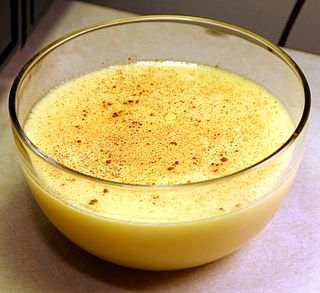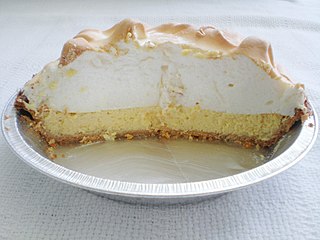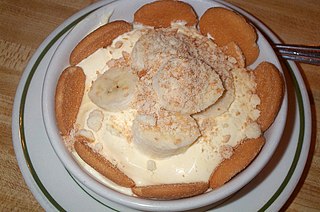 | |||||||
| Type | Pie | ||||||
|---|---|---|---|---|---|---|---|
| Course | Dessert | ||||||
| Main ingredients |
| ||||||
| 285 kcal (1193 kJ) | |||||||
| |||||||
Lemon meringue pie is a dessert pie consisting of a shortened pastry base filled with lemon curd and topped with meringue.
 | |||||||
| Type | Pie | ||||||
|---|---|---|---|---|---|---|---|
| Course | Dessert | ||||||
| Main ingredients |
| ||||||
| 285 kcal (1193 kJ) | |||||||
| |||||||
Lemon meringue pie is a dessert pie consisting of a shortened pastry base filled with lemon curd and topped with meringue.

Fruit desserts covered with baked meringue were found beginning in the 18th century in France. Menon's pommes meringuées are a sort of thick apple sauce or apple butter covered with baked meringue in his 1739 cookbook. [1] A custard flavored with "citron" (probably a mistranslation of citron 'lemon') and covered with baked meringue, crême meringuée, was published by 1769 in English, [2] apparently a translation of an earlier edition of Menon (1755?). [3] Similar recipes cooked in a crust appear in 19th century America: apple pie covered with meringue, called 'apple a la turque' (1832) [4] and 'apples meringuées' (1846). [5] A generic 'meringue pie' based on any pie was documented in 1860. [6] The name 'Lemon Meringue Pie' appears in 1869, [7] but lemon custard pies with meringue topping were often simply called lemon cream pie. [8] In literature one of the first references to this dessert can be found in the book 'Memoir and Letters of Jenny C. White Del Bal' by Rhoda E. White, published in 1868. [9] A chocolate meringue variant exists. [10] [11]
A stiff lemon-flavored custard is prepared with egg yolks, lemon zest and juice, sugar, and sometimes starch and baked in a pie crust. Uncooked meringue, usually shaped into peaks, is spread over the top, sometimes with a sprinkle of sugar, and briefly baked.

Dessert is a course that concludes a meal. The course consists of sweet foods, such as cake, biscuit, ice cream and possibly a beverage such as dessert wine and liqueur. Some cultures sweeten foods that are more commonly savory to create desserts. In some parts of the world there is no tradition of a dessert course to conclude a meal.

Custard is a variety of culinary preparations based on sweetened milk, cheese, or cream cooked with egg or egg yolk to thicken it, and sometimes also flour, corn starch, or gelatin. Depending on the recipe, custard may vary in consistency from a thin pouring sauce to the thick pastry cream used to fill éclairs. The most common custards are used in custard desserts or dessert sauces and typically include sugar and vanilla; however, savory custards are also found, e.g., in quiche.

A pie is a baked dish which is usually made of a pastry dough casing that contains a filling of various sweet or savoury ingredients. Sweet pies may be filled with fruit, nuts, fruit preserves, brown sugar, sweetened vegetables, or with thicker fillings based on eggs and dairy. Savoury pies may be filled with meat, eggs and cheese or a mixture of meat and vegetables.

An apple pie is a pie in which the principal filling is apples. Apple pie is often served with whipped cream, ice cream, custard or cheddar cheese. It is generally double-crusted, with pastry both above and below the filling; the upper crust may be solid or latticed. The bottom crust may be baked separately ("blind") to prevent it from getting soggy. Tarte Tatin is baked with the crust on top, but served with it on the bottom.

A soufflé is a baked egg dish originating in France in the early 18th century. Combined with various other ingredients, it can be served as a savoury main dish or sweetened as a dessert. The word soufflé is the past participle of the French verb souffler, which means to blow, breathe, inflate or puff.

Cheesecake is a dessert made with a soft fresh cheese, eggs, and sugar. It may have a crust or base made from crushed cookies, graham crackers, pastry, or sometimes sponge cake. Cheesecake may be baked or unbaked, and is usually served chilled.

Key lime pie is an American dessert pie. It is made of Key lime juice, egg yolks, and sweetened condensed milk. It may be served with no topping, with a meringue topping made from egg whites, or with whipped cream. Traditionally, Key Lime pie is made using a graham cracker crust. It may be made with or without baking in a pie crust or without crust. The dish is named after the small Key limes, which are more aromatic than the common Persian limes, and which have yellow juice. The filling in a Key lime pie is typically yellow because of the egg yolks.

A custard pie is any type of uncooked custard mixture placed in an uncooked or partially cooked crust and baked together. In North America, "custard pie" commonly refers to a plain mixture of milk, eggs, sugar, salt, vanilla extract and sometimes nutmeg combined with a pie crust. It is distinctly different from a cream pie, which contains cooked custard poured into a cooled, precooked crust. In the United Kingdom, the comical or political act of pieing is conventionally done with a "custard pie". Some common custard pies include pumpkin pie, lemon and buttermilk chess pie, coconut cream pie, and buko pie. True custard is defined as a liquid thickened with eggs. The often large number of whole eggs in custard pie make it very rich.

Chess pie is a dessert with a filling composed mainly of flour, butter, sugar, eggs, and sometimes milk, characteristic of Southern United States cuisine.

Apple crisp is a dessert made with a streusel topping. Ingredients usually include cooked apples, butter, sugar, flour, and cinnamon. The earliest reference to apple crisp in print occurs in 1924. Other similar desserts include apple Brown Betty, apple cobbler, apple crumble, apple pan dowdy, apple pie, and Eve's pudding.

Banana pudding is a dessert generally consisting of layers of sweet vanilla flavored custard, vanilla wafers and/or ladyfingers and sliced fresh bananas placed in a dish and served, topped with whipped cream or meringue.

A floating island or île flottante is a dessert consisting of soft meringue floating on crème anglaise. The meringue used is baked in a bain-marie. It may be served at room temperature or chilled.

Fruit curd is a dessert spread and topping. It is usually made with citrus fruit, though may be made with other fruits. Curds are often used as spreads and as flavourings.

An apple dumpling is a baked or boiled pastry-wrapped apple. To prepare apple dumplings, apples are peeled, cored and sometimes quartered and placed on a portion of dough. The hole from the core may be filled with cinnamon, butter and sugar and sometimes dried fruit such as raisins, sultanas, or currants. The dough is folded over the apples and sealed. Sometimes a spiced sauce is poured over the dumplings which are then baked until tender; the sugar and butter create a sweet sauce. Apple dumplings can be served hot, cold, or room temperature for breakfast, dessert, or as a main dish.

A lemon tart is a dessert dish, a variety of tart. It has a pastry shell with a lemon flavored filling.

Sponge cake is a light cake made with eggs, flour and sugar, sometimes leavened with baking powder. Some sponge cakes do not contain egg yolks, like angel food cake, but most of them do. Sponge cakes, leavened with beaten eggs, originated during the Renaissance, possibly in Spain. The sponge cake is thought to be one of the first non-yeasted cakes, and the earliest attested sponge cake recipe in English is found in a book by the British poet Gervase Markham, The English Huswife, Containing the Inward and Outward Virtues Which Ought to Be in a Complete Woman (1615). Still, the cake was much more like a cracker: thin and crispy. Sponge cakes became the cake recognised today when bakers started using beaten eggs as a rising agent in the mid-18th century. The Victorian creation of baking powder by British food manufacturer Alfred Bird in 1843 allowed the addition of butter to the traditional sponge recipe, resulting in the creation of the Victoria sponge. Cakes are available in many flavours and have many recipes as well. Sponge cakes have become snack cakes via the Twinkie.
Elizabeth Goodfellow (c.1767–1851), generally called Mrs. Goodfellow, started one of the first cooking schools in America. She taught classes for thirty years, and her recipes and techniques were passed on for generations in the cookbooks of one of her students, Eliza Leslie. Goodfellow also ran a renowned bakery and confectionery in Philadelphia during the first fifty years of the 19th century.

Pie in American cuisine evolved over centuries from savory game pies. When sugar became more widely available women began making simple sweet fillings with a handful of basic ingredients. By the 1920s and 1930s there was growing consensus that cookbooks needed to be updated for the modern electric kitchen. New appliances, recipes and convenience food ingredients changed the way Americans made iconic dessert pies like key lime pie, coconut cream pie and banana cream pie.